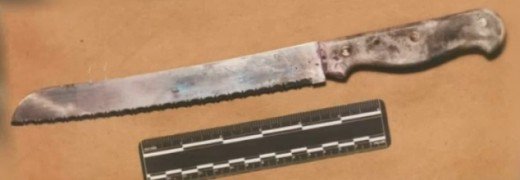The media reported the window was cut from the inside, but when the tests were conducted, the window had been cut from outside.
What the media reported is irrelevant. Charles Linch did testify that “there’s one microscopic finding that is more suggestive of it being punched (cut) from the outside.” But then the defense asked Linch a question that backfired on them.
Mosty: Doesn’t it seem logical to you that if you were going to cut a screen that you would have chosen one of the sharp-pointed knives?
Linch: I wouldn’t cut the screen. I would just pull it off the window.
(Charles Linch, Sec. 2989).
James Cron concurred.
Davis: Could you demonstrate for the jurors what it would take to remove the screen?
Cron: Yes. It has little tabs at the base that free the screen from the slot of the window frame. It’s easy to remove.
(James Cron, Sec. 2291)
 Supporters insist that if Darlie was going to cut the screen, she would have chosen a knife with a pointed blade, but that is a weak argument. As can be seen in the above photo, the bread knife did have a point, and being on the end of the butcher block, it was simple and quick to remove. For all we know, Darlie may have thought the serrated knife would cut more easily through the screen. Or perhaps she didn’t think at all. Perhaps she just grabbed the first knife her hand rested on.
Supporters insist that if Darlie was going to cut the screen, she would have chosen a knife with a pointed blade, but that is a weak argument. As can be seen in the above photo, the bread knife did have a point, and being on the end of the butcher block, it was simple and quick to remove. For all we know, Darlie may have thought the serrated knife would cut more easily through the screen. Or perhaps she didn’t think at all. Perhaps she just grabbed the first knife her hand rested on.
Conclusion
The cut screen was part of Darlie’s staging to point the finger at an intruder. With no experience or frame of reference, she attempted to make it look the way she thought it should if someone had broken in. Whether the screen was cut from the inside or outside, however, is of no consequence in the big picture, because the entire scenario defies logic. An intruder would have to somehow get in the house (there was no forced entry), grab the bread knife from the kitchen, go outside, cut
the screen, and replace the knife in the butcher block. He would then have to grab another knife, the butcher knife, to stab the victims. It make no sense.
The prosecution had the burden of proving Darlie’s guilt beyond a reasonable doubt. It did not have the burden of proving how she committed the crime beyond a reasonable doubt.